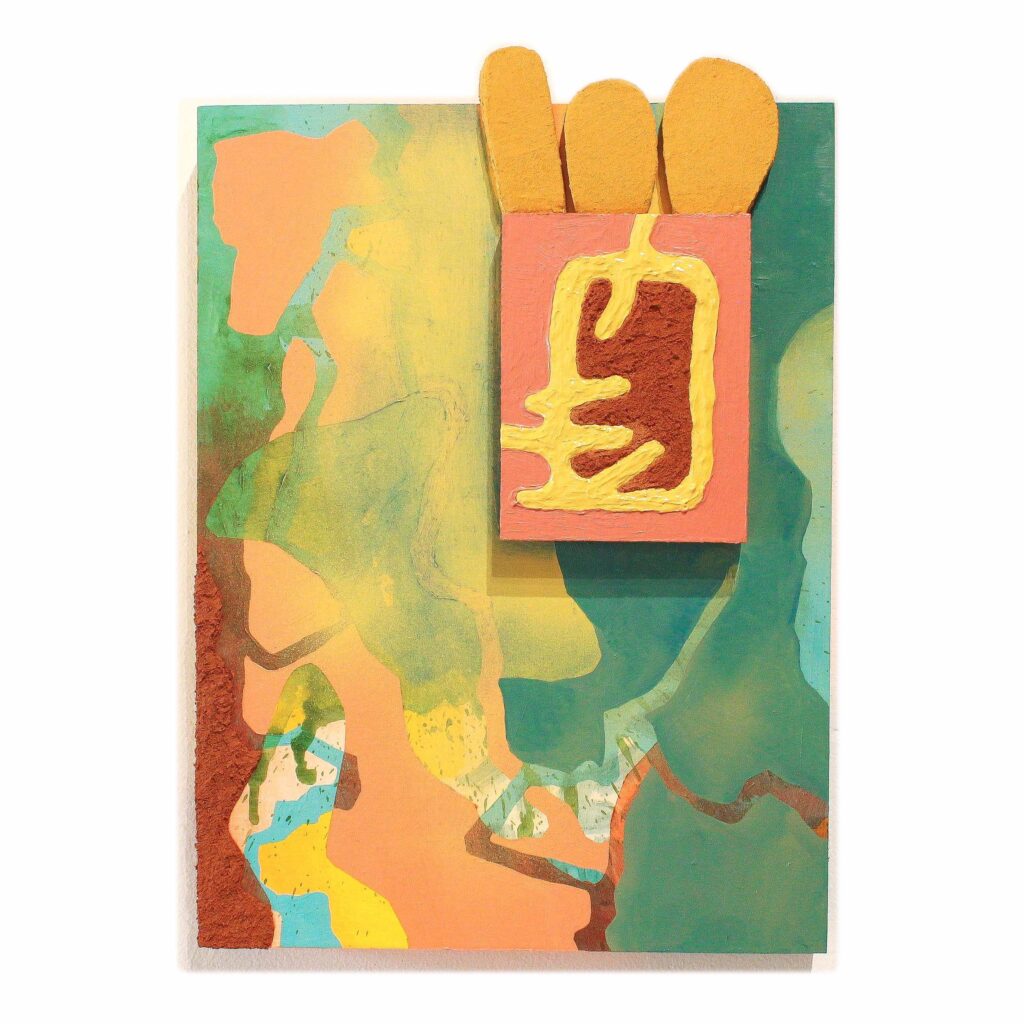Written by Lindsey Kircher.
Bottom left: A Place to Rest, 2020, acrylic and ink on mounted paper, stoneware in wooden box, 12 in x 10 in x 4 in; Bottom centre: Lunar Dust, 2020, oil, acrylic, sand, and stoneware in wooden box, 12 in x 10 in x 4 in; Bottom right: Let it Bounce, 2020, oil, acrylic, and spray paint on canvas, 28 in x 22 in.
Taking in the terracotta reds and yellows of Catie Dillon’s most recent work, I am reminded of the city of Rome. The recurrence of archways or portals, and the overlapping layers of translucent paint further evoke the collaged architecture, history, and culture of the city. Conversely, the saturated blues and neon greens of paintings such as “Let it Bounce,” transport the viewer to a tropical oasis, not unlike the luscious jungles of Laos or the beaches of Phuket.
It is worth noting that Catie and I have been close friends since 2016, when we met during a study abroad program in Ireland. Since then, we have been to more than ten countries together, including visits to all three aforementioned destinations of Rome, Laos, and Phuket. Having shared experiences as incredible as seeing Leonardo Da Vinci’s ethereal Last Supper masterpiece in Milan, to adventures as wild as sneaking backstage to hangout with a grungy ten-piece band in Galway, I feel I have unique insight into impactful moments that have shaped Catie’s painterly intuitions.
As the United States approaches a year anniversary of the initial lockdowns of the pandemic, it seems that Catie has leaned into painting as a means of revisiting travels that are currently inaccessible, at least physically. Her innovative layering of paint evokes a sense of ghostly disintegration, of seemingly unrelated memories blurring together and pulling apart. One cannot be sure of which marks were made first or last, just as one can become disoriented by the chronology of their own recollections of the past. Yet while these certain areas of the paintings beckon us closer, the artist maintains restraint, withholding information behind solid areas of color that often frame a window around the elusive layers underneath. This is the predicament we may all find ourselves in these days – gazing outwards from our little corner of the world, and looking back on memories of escape and change.
The experimental, investigative nature of the work extends beyond the range of painted marks. Having known Catie since she was sewing swatches of canvas and burlap together into mound-like forms, it is exciting to see her ceramics and sculpture communicate information she had previously limited to painting. The painted rocks at the base of her work “Lunar Dust” evoke a specific pitifulness through their physical presence. I recall the conflicting feelings of standing in front of the Temple of Delphi together, or exploring the Temples of Angkor Wat – held in awe by the presence of an ancient civilization, while struggling to visualize the society that occupied these ruins at the height of their splendor.
The three pairs of ceramic addendums in “Dancing Legs” function just as the artist intends them to, delivering the viewer to the thumping nightclubs and joyous dancing crowds of a time that now seems mythical or imagined. The red, swirly haze of the painting comforts us, reminding us that the sweaty heat and intensity of a dance party with friends and strangers was not just in our imagination, but something we experienced once and will hopefully be able to again. By expanding her paintings into a three-dimensional realm, Catie constructs evocative objects from her own experiences, and invites us to withdraw our own memories from the specific architecture of her work.
If you have never been lucky enough to travel with Catie or even to meet her in person, it cannot be difficult to appreciate these works as hieroglyphics that communicate a life of adventure, investigation, and open-mindedness. Condensing everything from sleepless nights in foreign cities to breathtaking encounters with ancient artworks and otherworldly landscapes into these small, painted objects, Catie creates work that beams dazzlingly beyond its size. Aren’t we fortunate to live in a world where everything has the potential to touch us, inspire us, and remain stored away in our brain until it one day re-emerges in a different form? I certainly feel fortunate to bear witness to the process of a friend who excels in this unique human gift.
About the artist: Catie Dillon is from Pittsburgh, PA. In 2018, she earned a BFA in Drawing and Painting from the Pennsylvania State University. Upon graduation, she attended Open Wabi Artist Residency in Fredericktown, Ohio and Fish Factory Residency in Stodvarfjordur, Iceland. Dillon has exhibited in New York, Pennsylvania, Ohio, and Italy. She was the recipient of the Alfred/Christy/Davis/Fink Creative Innovation Award as well as the Stefan J.S. Levine Endowment for creative research. Currently, she is based in Wassaic, New York, completing a fellowship at the Wassaic Project. Catie’s website is www.catiedillon.com and her instagram profile is @catieedillon.
About the writer: Lindsey Kircher was born in Paris, France and raised in the Washington, DC area. She earned a BFA in Drawing and Painting from the Schreyer Honors College at the Pennsylvania State University in 2019. Lindsey’s recent exhibitions include PUNCH at 5-50 Gallery in Long Island City, NY, the virtual summer juried show Congruence by I Like Your Work Podcast, and InsideOUT at the Atlantic Center for the Arts in New Smyrna Beach, FL. Her work has been featured in New American Paintings, ArtMaze Magazine and White Hot Magazine. Lindsey currently lives and works in Northern Virginia. Her website is www.lindseykircher.com and her instagram profile is: @linz_kirch.





